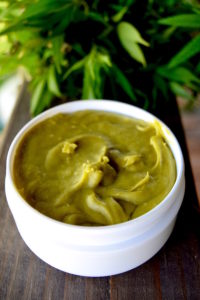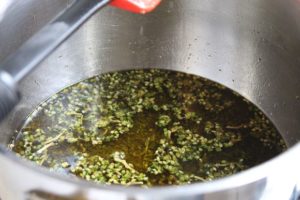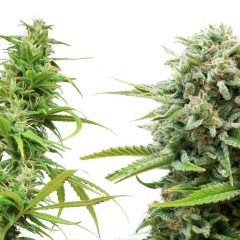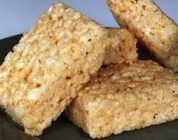 Creating a cannabis-infused coconut oil is just as simple as steeping quality herb in a good quality oil. There are machines are available to make cannabis-infused coconut oil but the infusion process can be done right on a stovetop or hot plate with the help of a double boiler.
Creating a cannabis-infused coconut oil is just as simple as steeping quality herb in a good quality oil. There are machines are available to make cannabis-infused coconut oil but the infusion process can be done right on a stovetop or hot plate with the help of a double boiler.
What You Will Need
- Double boiler (you can make one if you don’t own one)
- ¼ to ½ ounce of cannabis
- 1 cup of coconut oil (organic, expeller-pressed works best for this process)
- 2-3 feet of cooking twine (a clean unused white shoestring will work in a pinch)
- Cheesecloth (about an 8” x 10” piece)
TIP: A ratio of one quarter ounce of cannabis to one cup of oil is a good starting point. If you want a potent oil, high-quality flower (15%+ THC) works well. However, until you become more comfortable with the process or if you have limited funds, using shake, trim and/or kief work fine (avoid stems and seeds).
Cooking Directions
- Prepare the “herb packet”:
- Lay the cheese cloth out flat
- Place the cannabis (breaking up larger pieces) into the middle and distribute evenly over a small area (remember the packet needs to fit into the top pan)
- Fold in opposite ends to cover the herb
- Now fold in one of the open ends, tuck and roll
- Tie the roll of herb tightly with cooking twine (tying a knot in one end and then guiding the twine through it works good)
- Fill the bottom pan of a double boiler with a few inches of water (allowing enough space so that it does not touch the top pan) and set the shallow pan on top. Place over medium heat to a gentle boil – NOT a rolling boil.
 Add 1 cup of coconut oil to the top pan.
Add 1 cup of coconut oil to the top pan.- When the coconut oil is almost melted, add about 1 cup of water so that the liquid will cover the herb packet [Note: Coconut oil is nonpolar and water is polar so they will naturally separate when chilled; and THC and CBD are not soluble in water, but are in certain carrier oils. Therefore, the coconut oil acts as the carrier and will “soak” up the cannabinoids, leaving any impurities in the water.]
- Continue heating the oil and water mixture until all of the coconut oil is melted and then add the herb packet – pressing down gently into the liquid using a metal spoon.
- Cover and leave to cook for 90 minutes, checking back every half hour or so to flip over the packet and stir it around gently. Also, check the water in the bottom pan to make sure it is not boiling too hard and that the water level is still good – be careful to avoid any escaping steam when removing the top pan.
- After 90 minutes, the oil and water mixture should be a deep green color. At this point, turn off the heat and remove the herb packet and place in a bowl. Squeeze out any oil that is trapped in the “herb packet” by pressing with a spoon (when it cools down, you can give it another squeeze by hand to get every drop). Add this to the liquid mixture and place in the refrigerator to cool.
- When the mixture is cooled, the water and oil separate (dirty looking water on the bottom and a nice green color solidified oil containing the good stuff on top). Gently poke 2 or 3 holes through the oil, turn over (holding your hand gently over the oil) and drain the water off.
- If you are not going to use the oil immediately, store in a container (glass preferred) and label with date, strain and ratio. This will help you determine which strains and in what quantities work best for you.
The most important thing to remember is that the effects of consuming cannabis-infused coconut oil (directly or as an ingredient in a cooked dish) are usually slow-acting due to the cannabinoids having to be digested first. As such, it may take up to three (3) hours for you to feel its maximum effects, and those effects could last for awhile. If you find yourself feeling overwhelmed or concerned about overdosing, don’t panic — no one has ever died as a direct result of consuming cannabis.
Choosing the Right Strain
 Your next choice will be determining what strain(s) of cannabis to use. The infusion process does not drastically change the effects or flavors of the variety of cannabis used. Therefore, you will want to use a cannabis strain that delivers the desired effects you want to achieve (indica, sativa, hybrid, high-CBD). Most importantly, you want to be sure that the cannabis you use is free from impurities (such as mold, fungus, bugs, and pesticides). If the cannabis is compromised, the infusion process will not correct it.
Your next choice will be determining what strain(s) of cannabis to use. The infusion process does not drastically change the effects or flavors of the variety of cannabis used. Therefore, you will want to use a cannabis strain that delivers the desired effects you want to achieve (indica, sativa, hybrid, high-CBD). Most importantly, you want to be sure that the cannabis you use is free from impurities (such as mold, fungus, bugs, and pesticides). If the cannabis is compromised, the infusion process will not correct it.
Cooking Temperatures
Cannabinoids, terpenes and flavonoids are all affected differently by heat. A double boiler traps steam between the pans (provided you have a good seal) and remains steady about 212° F.
The most volatile terpenes will start to evaporate around 70° F (filling the air with a pungent aroma). A majority of the remaining terpenes will begin to evaporate rapidly around 100° F.
The boiling points of flavonoids range between 273.2° and 352.4° F, so the dominant flavors of the strain you use should still be evident in the infused oil.
Cannabinoids, specifically THC and CBD, exist in acidic and activated forms. In the plant, these cannabinoids exist almost entirely in the acidic form and are known as THCA and CBDA. When heated, these acidic forms undergo a chemical reaction called decarboxylation that results in THCA converting to THC and CBDA converting to CBD. Complete activation occurs when heated to 220° F for 90 minutes. In theory, the double boiler cooks at 212° F, but many factors can change that number, so you may need to experiment by adding or subtracting a few minutes to achieve your desired effects. Remember, if you are going to use the oil in a recipe that will expose it to further heat, you don’t want it to be fully activated at this stage.
Further, coconut oil has an average smoking point of 350° F, and can be very tricky to cook on direct heat. A double boiler cooks by steam so the oil doesn’t burn easily. Overcooking the oil compromises the fats and the taste will be most unappealing. If this happens, all you can do is throw it out, wipe the pan clean, and start over.
Health Benefits
 Cannabis and coconut oil are what some would call the perfect pair. Coupling coconut oil, “a vegan-friendly super food,” with cannabis, “nature’s miracle plant,” makes a lot of sense.
Cannabis and coconut oil are what some would call the perfect pair. Coupling coconut oil, “a vegan-friendly super food,” with cannabis, “nature’s miracle plant,” makes a lot of sense.
Coconut oil is a saturated oil made primarily of medium-chain fatty acids. It is safe to ingest in edible form and is easily digested. It gets its extra punch from lauric acid (C12), which comprises about 50% of the total fatty acids, and has been linked to many health benefits: reducing abdominal obesity, accelerating healing time for wounds, delivering antioxidant properties, lowering lipid components (e.g. cholesterol, triglycerides), preventing bone loss and more. Some people even use coconut oil as a daily detox.
Saturated fats have gotten a bad rap for decades. They have been accused of contributing to high cholesterol, heart disease, obesity, and even Alzheimer’s disease. Much confusion and contradictory evidence exists on the subject, even among health care professionals. Professionals, like Dr. Aseem Malhotra, are trying to set the record straight. Dr. Malhotra gained attention after the publication of his peer-reviewed editorial in the 2013 British Medical Journal (BMJ), wherein he seriously challenged the conventional view on saturated fats, and found no significant association between saturated fat and cardiovascular risk.
Coconut Oil Uses
There are so many things you can do with cannabis infused coconut oil including:
- Drizzle over hot cooked pastas, grains, cereals and vegetables
- Great for sauces and dressings
- Add to hot cooked soups and stews
- Use as a poultry rub
- Pan fry foods like scrambled egg, fish, bananas, chicken
- Put a spoonful in your coffee, tea or hot chocolate
- Add to smoothies




